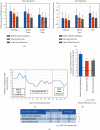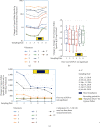Effects of a Cloth Panel Containing a Specific Ore Powder on Patients with Chamaecyparis obtusa (Cypress) Pollen Allergy
- PMID: 34803524
- PMCID: PMC8598349
- DOI: 10.1155/2021/3924393
Effects of a Cloth Panel Containing a Specific Ore Powder on Patients with Chamaecyparis obtusa (Cypress) Pollen Allergy
Abstract
Pollen allergy to Japanese cedar and cypress is a serious illness that impairs daily life and sleep, especially during pollen season. We have reported that placing a cloth panel containing a specific natural ore powder (CCSNOP) in a room may alleviate the symptoms of hay fever and may also benefit the immune system. This ore is from the Aso mountain range, a volcano on Kyushu Island in the southwestern part of Japan. The purpose of this study was to verify the effect of CCSNOP on cypress pollen. Thirty-one double-blind tests, which investigated cedar pollen allergies, were conducted from February to March 2018 and have already been reported. After this, in early April, 10 of these cases were recruited and all had CCSNOP installed in their bedrooms. Before that, various symptoms and changes in medication were recorded in a "Symptom Diary" and included a mood survey by a questionnaire, stress test using saliva amylase, changes in cypress-specific immunoglobulins IgE and IgG4 by blood sampling, and eosinophil changes. In addition, changes in 29 types of cytokines were investigated. Exposure to CCSNOP relieved symptoms and subjects decreased their intake of medication. There was no change in mood or stress, but eosinophil levels tended to decrease. Although there were no statistical changes in cypress-specific IgE or IgG4, an increase in the former and a decrease in the latter were observed in some individuals during the period of pollen dispersal. Furthermore, levels of GM-CSF and IL8 decreased significantly after use of CCSNOP. The CCSNOP was shown to be effective against cypress pollen allergy, and future investigations will be necessary to observe the long-term effects of CCSNOP.
Copyright © 2021 Suni Lee et al.
Conflict of interest statement
The authors declare that there are no conflicts of interest regarding the publication.
Figures






Similar articles
-
Effects of a Cloth Panel Containing a Specific Ore Powder on Patients with Japanese Cedar Pollen Allergy During the Pollen Dispersal Season.J Clin Med. 2019 Dec 6;8(12):2164. doi: 10.3390/jcm8122164. J Clin Med. 2019. PMID: 31817806 Free PMC article.
-
Biological Effects of Cloth Containing Specific Ore Powder in Patients with Pollen Allergy.Biomed Environ Sci. 2016 Aug;29(8):563-573. doi: 10.3967/bes2016.075. Biomed Environ Sci. 2016. PMID: 27660220 Clinical Trial.
-
Specific IgE to Japanese cypress (Chamaecyparis obtusa) in patients with nasal allergy.Ann Allergy Asthma Immunol. 1995 Apr;74(4):299-303. Ann Allergy Asthma Immunol. 1995. PMID: 7719888
-
Japanese cedar and cypress pollinosis updated: New allergens, cross-reactivity, and treatment.Allergol Int. 2021 Jul;70(3):281-290. doi: 10.1016/j.alit.2021.04.002. Epub 2021 May 4. Allergol Int. 2021. PMID: 33962864 Review.
-
Present situation of cedar pollinosis in Japan and its immune responses.Allergol Int. 2009 Jun;58(2):155-62. doi: 10.2332/allergolint.08-RAI-0074. Epub 2009 Mar 25. Allergol Int. 2009. PMID: 19307773 Review.
References
Publication types
MeSH terms
Substances
LinkOut - more resources
Full Text Sources
Medical
Miscellaneous

